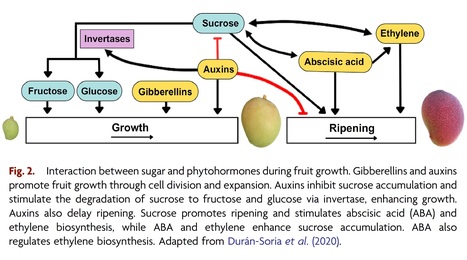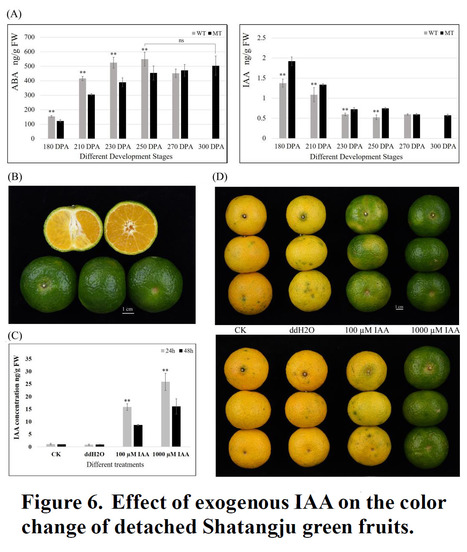 Your new post is loading...
 Your new post is loading...
Authors: Gerhard C. Rossouw, Ryan Orr, Dale Bennett and Ian S. E. Bally.
Functional Plant Biology (2024)
Abstract: "Reproductive development of fruiting trees, including mango (Mangifera indica L.), is limited by non-structural carbohydrates. Competition for sugars increases with cropping, and consequently, vegetative growth and replenishment of starch reserves may reduce with high yields, resulting in interannual production variability. While the effect of crop load on photosynthesis and the distribution of starch within the mango tree has been studied, the contribution of starch and sugars to different phases of reproductive development requires attention. This review focuses on mango and examines the roles of non-structural carbohydrates in fruiting trees to clarify the repercussions of crop load on reproductive development. Starch buffers the plant’s carbon availability to regulate supply with demand, while sugars provide a direct resource for carbon translocation. Sugar signalling and interactions with phytohormones play a crucial role in flowering, fruit set, growth, ripening and retention, as well as regulating starch, sugar and secondary metabolites in fruit. The balance between the leaf and fruit biomass affects the availability and contributions of starch and sugars to fruiting. Crop load impacts photosynthesis and interactions between sources and sinks. As a result, the onset and rate of reproductive processes are affected, with repercussions for fruit size, composition, and the inter-annual bearing pattern."
Authors: Shubham Temgire, Anis Ahmad Mirza, Abdul Waheed Wani, Kondle Ravi, Pratik Tanpure and Suprikesh Kadlag.
Annals of Phytomedicine (2023)
Abstract: "In warm climates, 'Crimson Seedless' may fail to develop an appropriate red colour, despite being a high-quality, red table grape (Vitis vinifera L.). Green berries also persist in most bunches even when the rest of the bunch has turned red. The plant hormone abscisic acid (ABA) is involved in the accumulation of anthocyanins in grape berry skin during maturation. Temperature increases are negatively affecting anthocyanin biosynthesis and other fruit quality characteristics in warmer regions of the world, making high-quality table grapes challenging to cultivate. Crop productivity and sustainability can be improved with nanotechnology. Table grapes are marketed based on their red colour, which is one of the most significant criteria for fruit quality. Several chemicals and practices were evaluated in this review to determine their effect on the bunch colour and metabolic profile of the grapevine variety, Crimson Seedless."
Authors: Jinfang Wang, Yanping Wang, Yongtao Yu, Zhang Jie, Yi Ren, Shouwei Tian, Maoying Li, Shengjin Liao, Shaogui Guo, Guoyi Gong, Haiying Zhang and Yong Xu.
Journal of Integrative Plant Biology (2023)
Abstract: "Watermelon (Citrullus lanatus) as non-climacteric fruit is domesticated from the ancestors with inedible fruits. We previously revealed that the abscisic acid (ABA) signaling pathway gene ClSnRK2.3 might influence watermelon fruit ripening. However, the molecular mechanisms are unclear. Here, we found that the selective variation of ClSnRK2.3 resulted in lower promoter activity and gene expression level in cultivated watermelons than ancestors, which indicated ClSnRK2.3 might be a negative regulator in fruit ripening. Overexpression (OE) of ClSnRK2.3 significantly delayed watermelon fruit ripening and suppressed the accumulation of sucrose, ABA and gibberellin GA4. Furthermore, we determined that the pyrophosphate-dependent phosphofructokinase (ClPFP1) in sugar metabolism pathway and GA biosynthesis enzyme GA20 oxidase (ClGA20ox) could be phosphorylated by ClSnRK2.3 and thereby resulting in accelerated protein degradation in OE lines and finally led to low levels of sucrose and GA4. Besides that, ClSnRK2.3 phosphorylated homeodomain-leucine zipper protein (ClHAT1) and protected it from degradation to suppress the expression of the ABA biosynthesis gene 9’-cis-epoxycarotenoid dioxygenase 3 (ClNCED3). These results indicated that ClSnRK2.3 negatively regulated watermelon fruit ripening by manipulating the biosynthesis of sucrose, ABA and GA4. Altogether, these findings revealed a novel regulatory mechanism in non-climacteric fruit development and ripening."
Authors: Jaclyn A. Adaskaveg and Barbara Blanco-Ulate.
Current Opinion in Biotechnology (2023)
Highlights • Fruit quality includes aspects of color, nutrition, flavor, texture, and shelf life. • Improving fruit quality can reduce food waste and increase nutritious food access. • Some consumer-based traits have declined with breeding longer shelf-life fruit. • Modulating ripening through breeding and biotechnology can improve fruit quality.
Abstract: "Fruit quality directly impacts fruit marketability and consumer acceptance. Breeders have focused on fruit quality traits to extend shelf life, primarily through fruit texture, but, in some cases, have neglected other qualities such as flavor and nutrition. In recent years, integrative biotechnology and consumer-minded approaches have surfaced, aiding in the development of flavorful, long-lasting fruit. Here, we discussed how specific transcription factors and hormones involved in fruit ripening can be targeted to generate high-quality fruit through traditional breeding and bioengineering. We highlight regulators that can be used to generate novel-colored fruit or biofortify fresh produce with health-promoting nutrients, such as vitamin C. Overall, we argue that addressing grower and industry needs must be balanced with consumer-based traits."
|
Authors: Ruo-Xi Zhang, Yudi Liu, Xian Zhang, Xiaomei Chen, Juanli Sun, Yun Zhao, Jinyun Zhang, Jia-Long Yao, Liao Liao, Hui Zhou and Yuepeng Han.
New Phytologist (2024)
Abstract: "Although maturity date (MD) is an essential factor affecting fresh fruit marketing and has a pleiotropic effect on fruit taste qualities, the underlying mechanisms remain largely unclear. In this study, we functionally characterized two adjacent NAM-ATAF1/2-CUC2 (NAC) transcription factors (TFs), PpNAC1 and PpNAC5, both of which were associated with fruit MD in peach. PpNAC1 and PpNAC5 were found capable of activating transcription of genes associated with cell elongation, cell wall degradation and ethylene biosynthesis, suggesting their regulatory roles in fruit enlargement and ripening. Furthermore, PpNAC1 and PpNAC5 had pleiotropic effects on fruit taste due to their ability to activate transcription of genes for sugar accumulation and organic acid degradation. Interestingly, both PpNAC1 and PpNAC5 orthologues were found in fruit-producing angiosperms and adjacently arranged in all 91 tested dicots but absent in fruitless gymnosperms, suggesting their important roles in fruit development. Our results provide insight into the regulatory roles of NAC TFs in MD and fruit taste."
Authors: Yuanda Lv, Shuang Ren, Bo Wu, Caizhong Jiang, Bo Jiang, Birong Zhou, Guangyan Zhong, Yun Zhong and Huaxue Yan.
Tree Physiology (2023)
Abstract: "Previous studies have shown that abscisic acid and ethylene are involved in pulp maturation and peel coloration in the nonclimacteric citrus fruits. There are also signs indicating that other plant hormones may play some roles in citrus fruit ripening. In this study, we compared profiles of genome-wide gene expression, and changes in hormones and peel pigments between fruits of Shatangju mandarin (Citrus reticulata Blanco, designated WT) and its natural mutant, Yuenongwanju (designated MT). The MT fruit mature approximately two months later than the WT fruit. Significant differences in fruit diameter, total soluble solids, titratable acid content, chlorophylls and carotenoids were detected between the fruits of the two genotypes at the sampled time points. Genome-wide transcriptome profiling showed that many genes involved in auxin and ABA metabolism and/or signaling pathways were differentially expressed between the MT and the WT fruits. Importantly, the expression of CrYUCCA8 was significantly lower and the expression of CrNCED5 was significantly higher in WT than in MT fruits at 230 and 250 DPA, respectively. In addition, the IAA level in the MT fruit was significantly higher than that in the WT counterpart, whereas a significantly lower level of ABA was detected in the mutant. Treatment of the WT fruit with exogenous IAA significantly delayed fruit maturation. Our results provide experimental evidence supporting the notion that auxin is a negative regulator of fruit maturation in citrus."
Authors: Jingyu Zhang, Yuhao Cao, Jia Tang, Xujie He, Ming Li, Chen Li, Xiaolin Ren and Yuduan Ding.
Horticulturae (2023)
Abstract: "Gibberellins (GAs) are plant hormones indispensable in regulating the growth and development of fruits. Recent studies have shown that GAs play important roles in delaying horticultural crop ripening and senescence, enhancing the internal and external quality of horticultural crops and resistance to stress and disease. We reviewed the role of GAs in the postharvest physiology of fruits in recent years. GAs are closely related to their ability to retard fruit senescence. GAs could effectively improve fruit storage quality and significantly increase flesh hardness, reduce respiration intensity, inhibit the release of endogenous ethylene, and effectively inhibit fruit softening and ripening. It can also improve the intrinsic and extrinsic quality of fruit storage by improving fruit shape, regulating color, delaying the reduction of soluble solids, promoting sugar accumulation, and delaying vitamin loss. GAs also play a role in postharvest biotic and abiotic stress resistance. The GA treatment effectively reduces the cold damage index, reduces the production and accumulation of superoxide anion(O2−), improves the antioxidant capacity of fruits, and maintains the integrity of cell membranes during low-temperature storage. Moreover, GAs could effectively control some postharvest fruit diseases. In conclusion, GAs play an important role in the physiological regulation of postharvest fruits and have important application prospects in postharvest fruits."
|
 Your new post is loading...
Your new post is loading...
 Your new post is loading...
Your new post is loading...
















